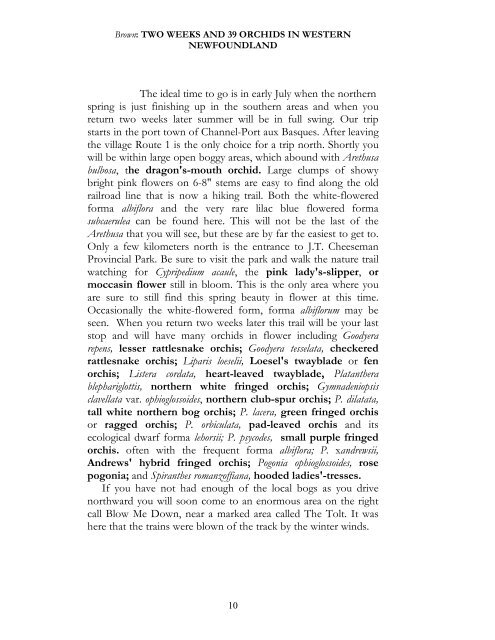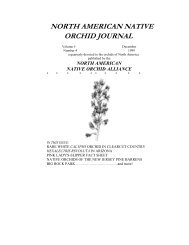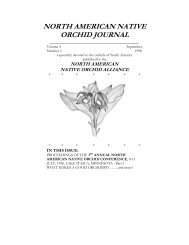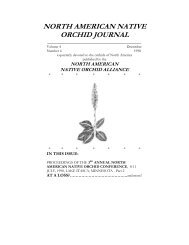north american native orchid journal - at The Culture Sheet
north american native orchid journal - at The Culture Sheet
north american native orchid journal - at The Culture Sheet
You also want an ePaper? Increase the reach of your titles
YUMPU automatically turns print PDFs into web optimized ePapers that Google loves.
Brown: TWO WEEKS AND 39 ORCHIDS IN WESTERN<br />
NEWFOUNDLAND<br />
<strong>The</strong> ideal time to go is in early July when the <strong>north</strong>ern<br />
spring is just finishing up in the southern areas and when you<br />
return two weeks l<strong>at</strong>er summer will be in full swing. Our trip<br />
starts in the port town of Channel-Port aux Basques. After leaving<br />
the village Route 1 is the only choice for a trip <strong>north</strong>. Shortly you<br />
will be within large open boggy areas, which abound with Arethusa<br />
bulbosa, the dragon's-mouth <strong>orchid</strong>. Large clumps of showy<br />
bright pink flowers on 6-8" stems are easy to find along the old<br />
railroad line th<strong>at</strong> is now a hiking trail. Both the white-flowered<br />
forma albiflora and the very rare lilac blue flowered forma<br />
subcaerulea can be found here. This will not be the last of the<br />
Arethusa th<strong>at</strong> you will see, but these are by far the easiest to get to.<br />
Only a few kilometers <strong>north</strong> is the entrance to J.T. Cheeseman<br />
Provincial Park. Be sure to visit the park and walk the n<strong>at</strong>ure trail<br />
w<strong>at</strong>ching for Cypripedium acaule, the pink lady's-slipper, or<br />
moccasin flower still in bloom. This is the only area where you<br />
are sure to still find this spring beauty in flower <strong>at</strong> this time.<br />
Occasionally the white-flowered form, forma albiflorum may be<br />
seen. When you return two weeks l<strong>at</strong>er this trail will be your last<br />
stop and will have many <strong>orchid</strong>s in flower including Goodyera<br />
repens, lesser r<strong>at</strong>tlesnake orchis; Goodyera tessel<strong>at</strong>a, checkered<br />
r<strong>at</strong>tlesnake orchis; Liparis loeselii, Loesel's twayblade or fen<br />
orchis; Listera cord<strong>at</strong>a, heart-leaved twayblade, Pl<strong>at</strong>anthera<br />
blephariglottis, <strong>north</strong>ern white fringed orchis; Gymnadeniopsis<br />
clavell<strong>at</strong>a var. ophioglossoides, <strong>north</strong>ern club-spur orchis; P. dil<strong>at</strong><strong>at</strong>a,<br />
tall white <strong>north</strong>ern bog orchis; P. lacera, green fringed orchis<br />
or ragged orchis; P. orbicul<strong>at</strong>a, pad-leaved orchis and its<br />
ecological dwarf forma lehorsii; P. psycodes, small purple fringed<br />
orchis. often with the frequent forma albiflora; P. xandrewsii,<br />
Andrews' hybrid fringed orchis; Pogonia ophioglossoides, rose<br />
pogonia; and Spiranthes romanzoffiana, hooded ladies'-tresses.<br />
If you have not had enough of the local bogs as you drive<br />
<strong>north</strong>ward you will soon come to an enormous area on the right<br />
call Blow Me Down, near a marked area called <strong>The</strong> Tolt. It was<br />
here th<strong>at</strong> the trains were blown of the track by the winter winds.<br />
10













